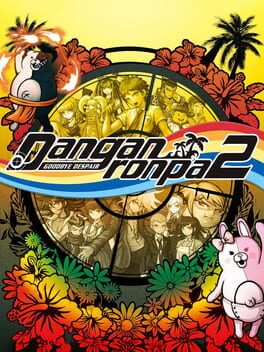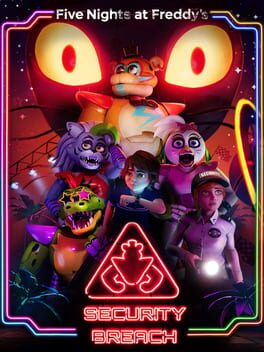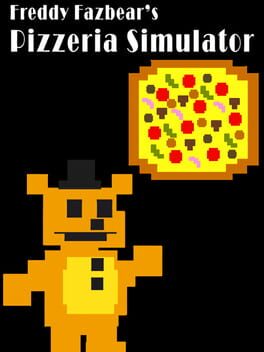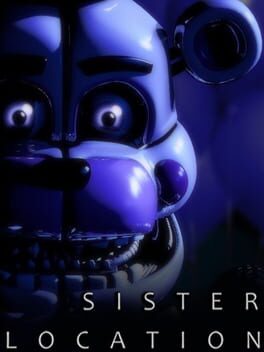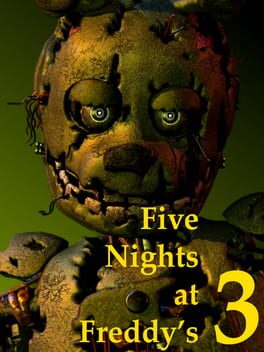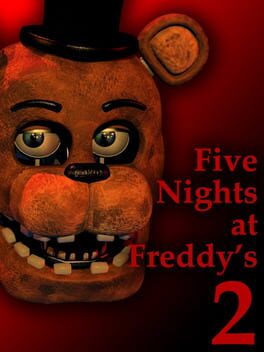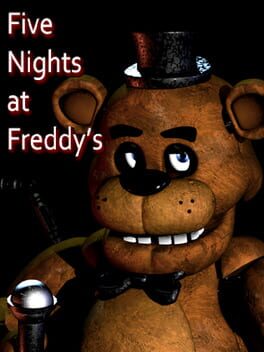MorbidAcuteness
11 reviews liked by MorbidAcuteness
If Danganronpa 1 was an off-the-wall detective black comedy silly game then this one is the fuckin syrup they used to dilute and make the first one. Atmosphere is definitely worse as it loses the trapped-ness of the first one and the mystery just doesn't feel as strong. HOWEVER, everything else is pretty much cranked to eleventy seven. Characters are fucking psychopaths but I love them and the trials and twists can sometimes seem like asspulls but damn it if I'm a sucker for just how insane it gets. Nagito Komaeda is also kind of the star and carries the game. Aside from being funny murder twink he is out of place in how interesting his character and motivation is compared to anyone else in the series. Banger character, made me appreciate everything else more. The bad trials in this one are worse than 1 but the goat trials are even better, so it evens out.
truly if five nights at freddys as a franchise is defined by Anything, its seeing how far u can stretch something obviously flawed on the strengths of the high level aesthetic experience...not just visually , but the core Feeling of Existing Within The Confines Of The Interactive Object. for the scott-created games, this mostly manifests in the fact that theres no Perfect Universal system for the fnaf gameplay loop...every game has different little imperfections and half baked ideas. what allows each game to be compelling, esp taken as a collective whole, is the wide range of appeals they offer, scratching different itches of interaction and atmosphere. they cover for eachothers weaknesses very often...if fnaf 1 isnt exciting enough for you jump to fnaf 2, if the lack of camera usage in fnaf 2 bugs u jump to fnaf 3, if fnaf 3 isnt tight enough jump to 4,,,all this means that none of the games are rly Towering Masterpieces, but they cover so much ground that theres probably at least One that is For You (ik i have my favorites!)
security breach rly takes this to its absolute breaking point...with previous fnaf games the individual entries were simple and polished, some rough edges but for the most part if u didnt like them it was due to a disagreement with the fundamental concepts rather then incompetent execution. security breach has no such armor to hide behind...it is full of flatly bad ideas, and full of flatly bad execution of those ideas. even playing the most patched and functional version of the game yet to exist, the seams come apart pretty often...but they stay together long enough to make it clear that even without that, this is not a good attempt at adapting fnaf to a 3d free roam environment. plays mostly like an absolutely trivial stealth game with occasional gimmicks and some needless frustration from undercooked player-hostile design like the save system. it took me nearly half the game to realize that when i was playing it as a trial and error stealth horror game, i was taking it far too much at its word...i had to stumble into a series of revelations of how weak and easily beatable the ai is, how useless the cameras are, and how generous your stamina is. and all this before getting an item to stun everyone! it was a conflicting disappointment...by taking the game seriously, and assuming it was capable of enforcing the intended playstyle, i had created friction and texture and tension and all the other stuff the game was clearly supposed to have, but i had also made it needlessly frustrating because even if u opt into the slow and steady route, the game barely holds it together anyway.
and yet...once i realized that i Wasnt playing a slow and frustrating stealth horror game, but instead a somewhat annoying but largely stress-free frictionless exploration game, i started to have genuinely tons of fun. whatever steelwool failed at, their misguided division of attention and resources paid off in the places that actually got focus...vibrant visuals and character designs, a wholly enveloping and instantly recognizable aesthetic identity, all spread across the absolute feat of Dreamy Architecture that is the pizzaplex. designed as full scale childhood wish fufillment to create The Coolest Possible Place To Have Your 10th Birthday Party first, a compelling place to explore and discover second, and an arena for stealth gameplay an astronomically distant third. but those first two pay OFF,,,,if nothing else, im sure ill come back and replay this game because i know i have so much more left to see in the pizzaplex, and im sure ill just miss the feeling of being in it. the commitment to making u a small and agile child running up and down this extremely appealing and lavishly lovingly rendered world might as well be the most vivid aesthetic appeal this series has yet managed...only rly surpassed by the Other fnaf game where u play as a child, but while 4 is a nightmare, SB is pure soaring dreams. in being so unsuccessful at subverting its cheery and colorful exterior for real horror, it simply inherits all the advantages of a cheery and colorful exterior.
it rly is just endlessly lovable, full of relentless charm and character, and what is achieved there intentionally brings a more likable levity to the numerous problems. it is pure ambition and energy without experience or temperament...ideally it could have everything obviously, but its hard to be angry at a game that just wants to blow yr mind this badly. so idk, why should i care that the fun game that i played isnt the one they meant to design! its there, i experienced it, and while im not soooo forgiving that i can overlook everything, this is almost certainly the entry in the series i am most inclined to go back to someday. as apt an illustration as anything of the limits of looking at game design as a formula to be solved by the developer, rather then an experience to be absorbed and reckoned with by the audience. much good is to be found here, you need only be willing to see it.
and besides which, are u rly telling me this is worse then sister location????? aint no way !!!!
security breach rly takes this to its absolute breaking point...with previous fnaf games the individual entries were simple and polished, some rough edges but for the most part if u didnt like them it was due to a disagreement with the fundamental concepts rather then incompetent execution. security breach has no such armor to hide behind...it is full of flatly bad ideas, and full of flatly bad execution of those ideas. even playing the most patched and functional version of the game yet to exist, the seams come apart pretty often...but they stay together long enough to make it clear that even without that, this is not a good attempt at adapting fnaf to a 3d free roam environment. plays mostly like an absolutely trivial stealth game with occasional gimmicks and some needless frustration from undercooked player-hostile design like the save system. it took me nearly half the game to realize that when i was playing it as a trial and error stealth horror game, i was taking it far too much at its word...i had to stumble into a series of revelations of how weak and easily beatable the ai is, how useless the cameras are, and how generous your stamina is. and all this before getting an item to stun everyone! it was a conflicting disappointment...by taking the game seriously, and assuming it was capable of enforcing the intended playstyle, i had created friction and texture and tension and all the other stuff the game was clearly supposed to have, but i had also made it needlessly frustrating because even if u opt into the slow and steady route, the game barely holds it together anyway.
and yet...once i realized that i Wasnt playing a slow and frustrating stealth horror game, but instead a somewhat annoying but largely stress-free frictionless exploration game, i started to have genuinely tons of fun. whatever steelwool failed at, their misguided division of attention and resources paid off in the places that actually got focus...vibrant visuals and character designs, a wholly enveloping and instantly recognizable aesthetic identity, all spread across the absolute feat of Dreamy Architecture that is the pizzaplex. designed as full scale childhood wish fufillment to create The Coolest Possible Place To Have Your 10th Birthday Party first, a compelling place to explore and discover second, and an arena for stealth gameplay an astronomically distant third. but those first two pay OFF,,,,if nothing else, im sure ill come back and replay this game because i know i have so much more left to see in the pizzaplex, and im sure ill just miss the feeling of being in it. the commitment to making u a small and agile child running up and down this extremely appealing and lavishly lovingly rendered world might as well be the most vivid aesthetic appeal this series has yet managed...only rly surpassed by the Other fnaf game where u play as a child, but while 4 is a nightmare, SB is pure soaring dreams. in being so unsuccessful at subverting its cheery and colorful exterior for real horror, it simply inherits all the advantages of a cheery and colorful exterior.
it rly is just endlessly lovable, full of relentless charm and character, and what is achieved there intentionally brings a more likable levity to the numerous problems. it is pure ambition and energy without experience or temperament...ideally it could have everything obviously, but its hard to be angry at a game that just wants to blow yr mind this badly. so idk, why should i care that the fun game that i played isnt the one they meant to design! its there, i experienced it, and while im not soooo forgiving that i can overlook everything, this is almost certainly the entry in the series i am most inclined to go back to someday. as apt an illustration as anything of the limits of looking at game design as a formula to be solved by the developer, rather then an experience to be absorbed and reckoned with by the audience. much good is to be found here, you need only be willing to see it.
and besides which, are u rly telling me this is worse then sister location????? aint no way !!!!
must finally concede my second fnaf dnf, and Also my second fnaf dnf of whats definitely some kind of minor masterpiece...the flow of rhythm between the three major sections is barrelling and near-flawless, always a bit disarming even tho i know whats coming. the office sections r predictably what broke me, much like fnaf4 the necessity of relying on subtle audio cues just combined rly badly with my sensory processing and the overwhelmingly vivid Aesthetic Horror (by far the best Shitty Office in this series), so i have to acknowledge my own limitations here unfortunately. i do genuinely love the design, it feels appropriately climactic as a Greatest Hits of all the previous games, including resurrecting my fave gameplay idea from sister location (disconnecting completion from a timer and instead putting it On U to finish the tasks at hand)...and ofc the contrast w/ the day sections is as vivid a demonstration as any of fnafs whole Something Menacing Hiding Under Something Innocent draw. famously this is also an excellent narrative crescendo, and the gravity of the true ending is a real testament 2 the contradicting facts that (1) fnaf prob should have had more straightforward narrative elements like this to rly get some vividness out of its material and (2) it kinda doesnt matter cuz weirdo jesus freak scott cawthon somehow pulled off the perfect magic trick anyway. like many ppl, my interest in these games narratively rly doesnt extend beyond the initial 6 games, which honestly might have less to do with the fact that theres Nothing Left To Do with the story and more with the fact that theyre never gonna pull off a magic trick like this again, and frankly given that fnaf is clearly now intended to be a Forever Property im not sure theyll even try. this is like the One Time that the series rly tried to say that everything Matters and that all yr investment was worth it, and ppl agreed. i do hope ill come back and experience everything for myself, i think its more likely here then fnaf 4, but as of now the dnf status is rly the only thing keeping me from confidently saying this is my fave game in the series
weird, conflicting, and ultimately kinda unfruitful (but not uninteresting!) mistep for me. i do See The Vision fwiw...the procedural and mechanical horror of the previous games loops exchanged for a tighter more varied experience that can deliver thru Intentionality and Control what cant be with random number generators that ask u to Respond To Their Chaos. aesthetically this is also perhaps my favorite entry besides 4,,,i know the pivot to far fetched sci fi tech alienated some fans but it all looks fucking awesome imo, my fave jumpscare animations in the series (anything with the faceplates rules) and an astonishingly good array of environmental and enemy designs. it feels like an opulent, Lavish production for being made by only one dude. i find myself wishing this was more of a Walking Simulator type thing, where i was allowed to just Exist in the tunnels...its a cool and spooky place to exist, and Existing In A Place is just ab the core of video games for me! far more then traditional Systems or Mechanics
unfortunately the actual play experience is the worst of both worlds...neither mechanically intricate nor unobtrusive enough to let me get completely lost in the vibes. as it stands it doesnt feel like a New Direction For The Series so much as No direction. in a sense it makes me appreciate the others more...a super linear series of minigames and scripted scares should have been far easier to pull off then an interestingly balanced and genuinely spooky set of interlocking mechanics, yet Weirdo Jesus Freak scott cawthon is astonishingly more adept at the latter! im told this gets even more proved in this games custom night, which i frankly Did Not Have The Patience To Unlock so that will be a blind spot for now! it seems cool tho !
would be remiss to not mention that this game is the Entire Reason to my understanding that fnaf lore exists as it currently does...creating and recontextualizing events past present and future, redefining it from a spooky story about a serial killer that may have been Dreamed Up By A Child to a story with actual characters, a specific set of power players with interlocking (familial) relationships. the afton family is a good dramatic bedrock for the series and mostly a positive development i think...certainly some rly striking stuff in here esp with the ennard ending. and the striking stuff happening in the Immediate Present is a nice development too ! theres real stuff to get invested in here, guts to be Punched, and family members make for something inherently emotionally stirring without having to devote too much time to characterization. ofc the hasty rewriting and recontextualizing by both cawthon and various theorists to account for these developments which were Clearly Not Envisioned From The Start creates quite a bit of roughness in the transition. im also not super super sold on Mad Scientist William Afton, robs him of a bit of the mystique he had when he was merely an urban legend child killer. but overall its a good reorientation that was probably necessary for Any catharsis to be achieved by the story of this series, kind of a magic trick in and of itself. perhaps its too much to expect that the reorientation of the actual play experience would pull off a similar miracle...ah well
unfortunately the actual play experience is the worst of both worlds...neither mechanically intricate nor unobtrusive enough to let me get completely lost in the vibes. as it stands it doesnt feel like a New Direction For The Series so much as No direction. in a sense it makes me appreciate the others more...a super linear series of minigames and scripted scares should have been far easier to pull off then an interestingly balanced and genuinely spooky set of interlocking mechanics, yet Weirdo Jesus Freak scott cawthon is astonishingly more adept at the latter! im told this gets even more proved in this games custom night, which i frankly Did Not Have The Patience To Unlock so that will be a blind spot for now! it seems cool tho !
would be remiss to not mention that this game is the Entire Reason to my understanding that fnaf lore exists as it currently does...creating and recontextualizing events past present and future, redefining it from a spooky story about a serial killer that may have been Dreamed Up By A Child to a story with actual characters, a specific set of power players with interlocking (familial) relationships. the afton family is a good dramatic bedrock for the series and mostly a positive development i think...certainly some rly striking stuff in here esp with the ennard ending. and the striking stuff happening in the Immediate Present is a nice development too ! theres real stuff to get invested in here, guts to be Punched, and family members make for something inherently emotionally stirring without having to devote too much time to characterization. ofc the hasty rewriting and recontextualizing by both cawthon and various theorists to account for these developments which were Clearly Not Envisioned From The Start creates quite a bit of roughness in the transition. im also not super super sold on Mad Scientist William Afton, robs him of a bit of the mystique he had when he was merely an urban legend child killer. but overall its a good reorientation that was probably necessary for Any catharsis to be achieved by the story of this series, kind of a magic trick in and of itself. perhaps its too much to expect that the reorientation of the actual play experience would pull off a similar miracle...ah well
there comes a time when i just have to throw my hands up and say I Cant Play This ! grasping the mechanics was not my issue, i did manage 3 of 5 nights, but a combination of factors make it so that this is the only horror thing i can recall abandoning in my adult life for being too scary. i genuinely feel nigh completely non-functional while in control of this thing, and considering the precision that im sure the later nights require, at some point i just have to admit i do not have the mental capacity to muscle thru this. that Intensity Of Reaction is ofc well worth applauding on its own, and the reason why i ultimately think of this fondly. i could see it being a bit Oversimplistic and not scaling super well to the later nights (u are just Doing The Same Thing Over And Over with less and less room for error), but there is deffo something to be said for how theres just No Fat On It Designwise, every single tool and state of the bedroom is in constant use. by nature this is also the entry that leans the most into Expressionism, the nightmare animatronics are some of my favorite designs in the series i just love that Embellished Child POV stuff, which prob has a lot to do with why i find this so scary in the first place. there is no swinging between empowerment and disempowerment here, its All Disempowerment All The Time, yet still puts an incredibly stressful amount of Gameplay Responsibility on me. altogether its Pretty Unbearable, and also a weird Intended Conclusion for the series what with all the dream stuff? a less satisfying finale then fnaf3 for sure. but by far the most vivid Textural Experience of any of these for me, i gotta give it high marks even without seeing it thru. crying child kinnie era
FNAF 3 HATERS TOO WEAK TO LIVE !!! didnt take me but 30 minutes to realize this is easily my favorite of the original trilogy...tho in a way im not sure i would appreciate it so much without being able to understand its beautiful opposing mirror view of fnaf 2. im kinda sad this idea of One Animatronic doesnt rly seem to be revisited anywhere else in the series...where in fnaf 2 it basically doesnt matter where an enemy is unless theyre already in or right by your office, fnaf 3 demands Total Deliberacy, internalizing the ever-quickening pace of springtraps movement as well as the spaces he's moving thru are essential (im sure even more so in the post-night 5 challenges, which i am also eager to return to sometime). the effect created then is a hard-earned hyper-satisfying Total Intimacy...with springtrap, with the layout of rooms and vents, with the various tics of the phantomtronics. this is prob at least part of the game's lesser reputation, its not very Lets Playable...difficult to follow if yr not the one playing, not much immediate spectacle or instant visable feedback, and generally Weird To Learn! but the friction is totally worth it imo, gameplay-wise this is easily the most compelling set of rules so far to me, not so much a Loop as the previous games (tho u can try to make it a loop!), more ab slightly longer-term decisions. i mentioned the swing between Power and Powerlessness fnaf 1 managed with its cameras, and thats Even More Pronounced here with the difference between Knowing Where Springtrap Is and Not Knowing Where Springtrap is...a wonderful eb and flow of panicked searching and careful decision making.
attempting to sorta Psychologically Compartmentalize these games thinking ab them As They Were On Release, knowing this was supposed to be the last one rly paints like a whole different picture of the series...more Arch Urban Legend then convoluted lore, and a rly cool little trilogy that establishes its broad formula and then iterates on it in two opposite directions. in that way this totally feels appropriately climactic to me, not just cuz i Love It A Lot tho that helps, but because it brings such a sense of symmetry to the series. its not quite perfect perhaps...the phantoms have to be some of the least interesting design variations in the series ofc dhsjhfs. but overall yea my fave so far and an Industrial Classic of video game aesthetics, including in its play! i aint gonna try to justify that u just gotta feel it!
attempting to sorta Psychologically Compartmentalize these games thinking ab them As They Were On Release, knowing this was supposed to be the last one rly paints like a whole different picture of the series...more Arch Urban Legend then convoluted lore, and a rly cool little trilogy that establishes its broad formula and then iterates on it in two opposite directions. in that way this totally feels appropriately climactic to me, not just cuz i Love It A Lot tho that helps, but because it brings such a sense of symmetry to the series. its not quite perfect perhaps...the phantoms have to be some of the least interesting design variations in the series ofc dhsjhfs. but overall yea my fave so far and an Industrial Classic of video game aesthetics, including in its play! i aint gonna try to justify that u just gotta feel it!
rly rly apt illustration of the distance, often painfully unacknowledged in Mechanical Games Criticism, between compelling game design and Theoretically Perfect game design. thinking ab it i can come up with a bunch of objections to raise to this: all the cameras except one might as well not be there, the lack of mechanical individuality among the animatronics, the abundance of moving parts making it so that just getting Bad Lucked into an impossible-to-win situation is a lot more likely, and more then anything the emphasis on reactivity means that its not so much a game ab Strategizing or Making Decisions as fnaf1, at least no decisions that will be relevant more then a music box's cycle away. but these High Level ideas ab how parts Should click together dont actually feel all that relevant (or at least Detrimental) to the actual moment to moment experience of my playing this, which i find even more enjoyable then the first ! its just an endless cascade of split second decisions, theres always something demanding yr attention, and the vocabulary of reactions is very simple and manageable to learn, u just gotta learn to match em up with the memorable cast of robots. much better use of audio cues in this one too, i understood the purpose of their vagueness in the original but i prefer the increased clarity of information here, and the relative forgiveness of having yr Reaction Time Tested rather then Instant Death upon misreading that information. its nowhere near as Scary ofc...the atmosphere in general has honestly been pretty Gutted on the altar of colorful designs and slick shininess, this always feels a bit more distant and cartoony then the hyper-tactile original. still! im not rly playing past night 5 in these initial playthrus but i think i will come back to this one's challenges cuz i just think its super duper fun to play! lots of chemicals being set off at all times
tho it prob has something 2 do with the fact that i vividly remember when this first came out (was the only one i actually paid attention to at release) and never getting past night 3, i rly admire that even mountains of overexposure later playing this still feels convincingly like interacting with some sorta Cursed Object, more effectively in its shiny commercial package then any of those esoteric creepypasta EXEs i can care to remember. even with a million sequels in vastly different aesthetic directions this still feels p lightning in a bottle, its specific mixture of Old And Shitty But Not Overtly Nightmarish in its vibe rly makes it feel like this tangible thing, weirdly cozy and electric blankety (even trying my best to consider for nostalgia) with the feeling of pitch black secrets oozing out of view. helps that i rly rly love the designs in this one, lots of weight and just generally imposing physical presence in their overt chunkiness.
im not good at analyzing mechanical stuff but i appreciate how everything clicks together here a lot...the cameras in particular, are this amazing combination of Power and Powerlessness, they tend to feel a lot safer when yr in them cuz of the Layer Of Removal (and also how much information u have access to) but the split-second process of entering and exiting them bookends the whole experience with a little Pierce of anxiety,,,rly compelling micro-emotional flow worked into the practical mechanical loop of tearing u from the cameras to the office over and over. it stops being Spooky after a certain point obviously but thats fine ! its offering a nice little challenging game in return. tho it does seem like what ive praised here falls away a bit at high levels of play where the cameras are barely used, even playing only to night 5 i got to a point where i basically only needed the foxy camera and the freddy far corner camera. perhaps a more rigorously designed system would be able to withstand that amount of pressure, but i always find it a bit pointless to criticize things for not living up to some Ideal. this is v good work and would be a memorable blip on my memories even without the larger franchise
im not good at analyzing mechanical stuff but i appreciate how everything clicks together here a lot...the cameras in particular, are this amazing combination of Power and Powerlessness, they tend to feel a lot safer when yr in them cuz of the Layer Of Removal (and also how much information u have access to) but the split-second process of entering and exiting them bookends the whole experience with a little Pierce of anxiety,,,rly compelling micro-emotional flow worked into the practical mechanical loop of tearing u from the cameras to the office over and over. it stops being Spooky after a certain point obviously but thats fine ! its offering a nice little challenging game in return. tho it does seem like what ive praised here falls away a bit at high levels of play where the cameras are barely used, even playing only to night 5 i got to a point where i basically only needed the foxy camera and the freddy far corner camera. perhaps a more rigorously designed system would be able to withstand that amount of pressure, but i always find it a bit pointless to criticize things for not living up to some Ideal. this is v good work and would be a memorable blip on my memories even without the larger franchise
It is the year 198X. Fragile lives persist in the flow of electric frames, traveling wide across the pre-Internet infrastructure, looking for someone or something. The progeny of the ARPANET, Community Memory, and PLATO networks now spread from one bulletin board system (BBS) to another, bringing the soapbox nature of CB radio into the information age. But danger lurks beneath all this novelty and optimism. The Cold War looms as ever, and rogue threats come in many guises, from hackers to aberrant chatbots. Anything can happen in this world, so long as it runs on telephone wire.
That's the romanticized frame through which this early standout from the 2010 RenPy scene immerses and involves you. A few older puzzle and adventure titles had already dabbled with diegetic story-telling about and set within earlier, tight-knit computerized communities. There's the seminal Hacker from 1985, combining illicit access with a cinematic plot (later succeeded by 2001's Uplink). La femme qui ne supportait pas les ordinateurs, also an '85 release, told a more personal tale of a woman dealing with sexual harassment on France's proto-BBS system called Minitel. But a fully character-driven plot combining these BBS-era subjects into one cohesive story, yet relatable to a post-Internet age? It's hardly what author Christine Love had set out to accomplish, yet here we are.
Today you can find plenty of these "literal computing games" where you mainly interact with a fictional PC or terminal interface, doing anything from traversing networks to forensics or surveillance work, etc. Digital manages to do a bit of everything without spreading itself too thin. You start off just learning the basics of your Amie Workbench OS (oh how I love the blatant Amiga-ness throughout!) before meeting welcoming strangers on your local nets. This quickly turns into a larger mystery when your new friend and potential lover Emilia goes missing, all while the BBS you chatted on has gone up in smoke. Thankfully you know a few others willing to help figure out what's going on, either by providing shady software in messages or giving you useful information like phone numbers. You do all this while jamming out to what sounds suspiciously like mod-tracker music, complementing the Amiga stylings of your desktop.
C. Love was already a known quantity in NaNoRenMo game jams, writing one or more short but satiating visual novels within a month. This wasn't meant to be any different, but the game made a strong first impression that lasts to this day. Booting into Amie, laboriously typing in each address to dial up networks, and hearing that gloriously shrill modem song every time…it's all here, fellas. The UI mechanics used in Digital: A Love Story make it easy to slip into a period-accurate mindset; clever quality-of-life shortcuts, like your notepad switching tabs based on context, keep your playthrough smooth and well-paced despite the intentional tedium. I had a lot of fun just downloading & replying to each public or private message, as well as guessing passwords or even the penultimate BBS' address before the story gave me a direct clue.
So there's a strong interplay between these light textual puzzles and the simple but engrossing alternate history you uncover along the way. The whole concept of accidentally creating a self-evolving AI, which itself needs to create separate network nodes to store its compartmentalized personalities, is compelling on its own (if not exactly original). We quickly go from thinking we were talking to a basic chatbot this whole time to grokking the sheer scope of techno-existential advancement. Digital excels at wrapping an idealized history of the real BBS milieu with an alternate history needed both for plot and after-the-fact critique. This also allows C. Love to justify your main cast interactions by having a unifying antagonist, which you only deal with indirectly. The game provides more than a few good reasons to care about Emilia and the friends you make along the way, inching towards a suitably cyberpunk-ish calamity.
Digital isn't afraid to indulge many classic cyberpunk ideas, usually for good reason. You're not going to bust down any corporation's doors or upset the military-industrial complex here, but spoofing long-distance calling card numbers rarely gets old. I wish the game provided many more gizmos to download and use from your desktop, not just one or two plot trinkets like a brute-force password cracker or C recompiler. Still, having these interface doodads to mess with is fun even before their progression utility. I've already spoiled quite a bit for this admittedly 2-hour game, but I'll say its take on near-future AIs and their human interactions is serviceable. Nothing here's as compelling as the William Gibson examples alluded to mid-way through, just solidly characterized in that late-'80s genre mold. The most cyberpunk we get here, otherwise, is a positive outlook on casual hacking in a time before federal regulations and enforced oversight curbed the power of grassroots networks, thus incentivizing adoption of the Internet & WWW.
What's clearly more on C. Love's mind this whole time is the nature of remote relationships. Finding out the truth behind Eliza's disappearance may be the main plot thrust, but understanding why she's fallen in love with you is nearly as important. The creator's said in later blogs & interviews how she wanted to balance a universal love story with romantic themes relatable to a queer audience much like herself. (Any cursory look at her works since will show much this matters to her!) The whole premise of finding a deep, inter-personal connection via the most remote means a lot more when talking about historically marginalized LGBTQIA+ people. Running into a sapphic chatbot, one whose first post on your home BBS is literally a love poem, is all too believable and relevant. Later on, you'll run into a user posting a series of fantasy wargames (which, like other games warez, isn't playable here due to the game's quick dev time), all of which involve a lesbian warrior queen. Cyberpunk can and should highlight people forced into the periphery of the mainstream, those who fight back against a harmful status quo even at their own expense.
Story ending spoilers ahead!
This all comes together when, after reviving Eliza on your Amie PC using a compiler and her crash dump/log, she endeavors to defeat Reaper at the cost of her own digital life. For as much as she loves you, the player, her biggest concern now is saving all the aspects of Mother from this rogue worm meant to keep them all in check. Sure enough, trying to access any networks at end-game is futile, as Reaper's bulldozed through every system it can, with nothing but black screens of death remaining. Putting a larger existential goal before one's love is no easy decision, and I'm still not convinced this works much better than a typical kill-your-gays plot resolution. To the writer's credit, Eliza gives you all the warning, apologies, and resignation one could while asking to be armed with an anti-viral payload that will destroy her as well. It's your choice whether or not to see this tragic comedy through to the end.
Plot spoilers end here
Given the unsubtle nods to Shakespeare, and Digital's generally hopeful outlook on how cyberpunk elements can bleed into our world without destroying us or enriching the 1%, I think the story ended on steady ground. There's a cool outro with commentary from BBS users recalling the plot's events, and the game has an unction of replay value in case you want to look for more lore hidden in plain sight. I could do this all over again just for the smartly written bantz between amateurs and pros across each node! But this ended up being a memorable one-and-done too, effortlessly meshing its diegetic play with a likable dramedy. Digital: A Love Story became a surprise cause celebre not long after its release, making C. Love's career and paving the way for countless newer computing adventures throughout indie circles. It's a swift play and, for me, practically required to understand the origins of this genre movement as it exists now.
That's the romanticized frame through which this early standout from the 2010 RenPy scene immerses and involves you. A few older puzzle and adventure titles had already dabbled with diegetic story-telling about and set within earlier, tight-knit computerized communities. There's the seminal Hacker from 1985, combining illicit access with a cinematic plot (later succeeded by 2001's Uplink). La femme qui ne supportait pas les ordinateurs, also an '85 release, told a more personal tale of a woman dealing with sexual harassment on France's proto-BBS system called Minitel. But a fully character-driven plot combining these BBS-era subjects into one cohesive story, yet relatable to a post-Internet age? It's hardly what author Christine Love had set out to accomplish, yet here we are.
Today you can find plenty of these "literal computing games" where you mainly interact with a fictional PC or terminal interface, doing anything from traversing networks to forensics or surveillance work, etc. Digital manages to do a bit of everything without spreading itself too thin. You start off just learning the basics of your Amie Workbench OS (oh how I love the blatant Amiga-ness throughout!) before meeting welcoming strangers on your local nets. This quickly turns into a larger mystery when your new friend and potential lover Emilia goes missing, all while the BBS you chatted on has gone up in smoke. Thankfully you know a few others willing to help figure out what's going on, either by providing shady software in messages or giving you useful information like phone numbers. You do all this while jamming out to what sounds suspiciously like mod-tracker music, complementing the Amiga stylings of your desktop.
C. Love was already a known quantity in NaNoRenMo game jams, writing one or more short but satiating visual novels within a month. This wasn't meant to be any different, but the game made a strong first impression that lasts to this day. Booting into Amie, laboriously typing in each address to dial up networks, and hearing that gloriously shrill modem song every time…it's all here, fellas. The UI mechanics used in Digital: A Love Story make it easy to slip into a period-accurate mindset; clever quality-of-life shortcuts, like your notepad switching tabs based on context, keep your playthrough smooth and well-paced despite the intentional tedium. I had a lot of fun just downloading & replying to each public or private message, as well as guessing passwords or even the penultimate BBS' address before the story gave me a direct clue.
So there's a strong interplay between these light textual puzzles and the simple but engrossing alternate history you uncover along the way. The whole concept of accidentally creating a self-evolving AI, which itself needs to create separate network nodes to store its compartmentalized personalities, is compelling on its own (if not exactly original). We quickly go from thinking we were talking to a basic chatbot this whole time to grokking the sheer scope of techno-existential advancement. Digital excels at wrapping an idealized history of the real BBS milieu with an alternate history needed both for plot and after-the-fact critique. This also allows C. Love to justify your main cast interactions by having a unifying antagonist, which you only deal with indirectly. The game provides more than a few good reasons to care about Emilia and the friends you make along the way, inching towards a suitably cyberpunk-ish calamity.
Digital isn't afraid to indulge many classic cyberpunk ideas, usually for good reason. You're not going to bust down any corporation's doors or upset the military-industrial complex here, but spoofing long-distance calling card numbers rarely gets old. I wish the game provided many more gizmos to download and use from your desktop, not just one or two plot trinkets like a brute-force password cracker or C recompiler. Still, having these interface doodads to mess with is fun even before their progression utility. I've already spoiled quite a bit for this admittedly 2-hour game, but I'll say its take on near-future AIs and their human interactions is serviceable. Nothing here's as compelling as the William Gibson examples alluded to mid-way through, just solidly characterized in that late-'80s genre mold. The most cyberpunk we get here, otherwise, is a positive outlook on casual hacking in a time before federal regulations and enforced oversight curbed the power of grassroots networks, thus incentivizing adoption of the Internet & WWW.
What's clearly more on C. Love's mind this whole time is the nature of remote relationships. Finding out the truth behind Eliza's disappearance may be the main plot thrust, but understanding why she's fallen in love with you is nearly as important. The creator's said in later blogs & interviews how she wanted to balance a universal love story with romantic themes relatable to a queer audience much like herself. (Any cursory look at her works since will show much this matters to her!) The whole premise of finding a deep, inter-personal connection via the most remote means a lot more when talking about historically marginalized LGBTQIA+ people. Running into a sapphic chatbot, one whose first post on your home BBS is literally a love poem, is all too believable and relevant. Later on, you'll run into a user posting a series of fantasy wargames (which, like other games warez, isn't playable here due to the game's quick dev time), all of which involve a lesbian warrior queen. Cyberpunk can and should highlight people forced into the periphery of the mainstream, those who fight back against a harmful status quo even at their own expense.
Story ending spoilers ahead!
This all comes together when, after reviving Eliza on your Amie PC using a compiler and her crash dump/log, she endeavors to defeat Reaper at the cost of her own digital life. For as much as she loves you, the player, her biggest concern now is saving all the aspects of Mother from this rogue worm meant to keep them all in check. Sure enough, trying to access any networks at end-game is futile, as Reaper's bulldozed through every system it can, with nothing but black screens of death remaining. Putting a larger existential goal before one's love is no easy decision, and I'm still not convinced this works much better than a typical kill-your-gays plot resolution. To the writer's credit, Eliza gives you all the warning, apologies, and resignation one could while asking to be armed with an anti-viral payload that will destroy her as well. It's your choice whether or not to see this tragic comedy through to the end.
Plot spoilers end here
Given the unsubtle nods to Shakespeare, and Digital's generally hopeful outlook on how cyberpunk elements can bleed into our world without destroying us or enriching the 1%, I think the story ended on steady ground. There's a cool outro with commentary from BBS users recalling the plot's events, and the game has an unction of replay value in case you want to look for more lore hidden in plain sight. I could do this all over again just for the smartly written bantz between amateurs and pros across each node! But this ended up being a memorable one-and-done too, effortlessly meshing its diegetic play with a likable dramedy. Digital: A Love Story became a surprise cause celebre not long after its release, making C. Love's career and paving the way for countless newer computing adventures throughout indie circles. It's a swift play and, for me, practically required to understand the origins of this genre movement as it exists now.
A small-scale scifi story about coding errors and dialing numbers you shouldn't know about. I revisited this after being disappointed with Analogue: A Hate Story, and it's remarkable how similar and how much more successful Digital is despite (and perhaps because of) being a more straightforward project.
Out of all Christine Love's games I've played, Digital is the most sincere, concerned less with sweeping political allegories than with melancholic nostalgia and very deliberate interactions. Typing phone numbers and running down a list of free long distance codes is the most intense Digital ever gets, but wrapping these inputs in a blunt lo-fi interface causes them to wrap back around to feeling like each number is a bold step into the unknown.
I'm still very down on Christine Love's prose, but what's here benefits from fully obfuscating player responses (you see the reply to your reply but not what prompts it, providing some much needed ambiguity). The love story is by far the weakest part, due mostly to a lack of time to develop the romantic interest and the second half crashing into a pretty boring computer virus drama. It was surprising just how little the actual BBS interactions matter compared to the tactile experience of using them. It's a lonely game in that respect, but I'm happy to drift alone between boards when dialing in feels this good.
Out of all Christine Love's games I've played, Digital is the most sincere, concerned less with sweeping political allegories than with melancholic nostalgia and very deliberate interactions. Typing phone numbers and running down a list of free long distance codes is the most intense Digital ever gets, but wrapping these inputs in a blunt lo-fi interface causes them to wrap back around to feeling like each number is a bold step into the unknown.
I'm still very down on Christine Love's prose, but what's here benefits from fully obfuscating player responses (you see the reply to your reply but not what prompts it, providing some much needed ambiguity). The love story is by far the weakest part, due mostly to a lack of time to develop the romantic interest and the second half crashing into a pretty boring computer virus drama. It was surprising just how little the actual BBS interactions matter compared to the tactile experience of using them. It's a lonely game in that respect, but I'm happy to drift alone between boards when dialing in feels this good.
